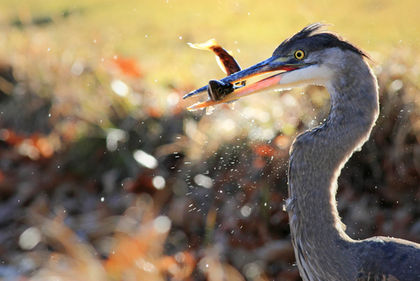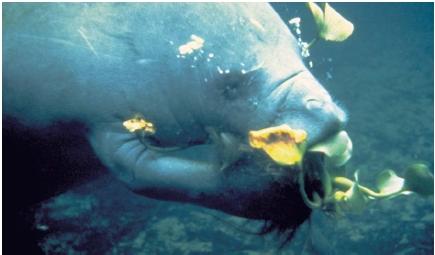Food web and food chain

The terms food chain and food web both refer to groups of organisms that are dependent on each other for food. A food chain is a single series of organisms in which each plant or animal depends on the organism above or below it. As an example, a food chain might consist of garden plants, such as lettuce and carrots, fed upon by rabbits which, in turn, are fed upon by owls which, in turn, are fed upon by hawks.
A food chain is largely a theoretical idea and probably seldom, if ever, exists in the real world. It is a useful concept, however, as it helps ecologists understand how specific plants and animals are dependent upon one another.
The feeding relationships of organisms in the real world is almost always more complex than suggested by a food chain. For that reason, the term food web is more accurate than is food chain. A food web differs from a food chain in that it includes all the organisms whose feeding habits are related in some way or another to those of other organisms. In the example above, small animals other than rabbits feed on lettuce and carrots and, in turn, those animals are fed upon by a variety of larger animals.
Structure of food webs
Food webs are organized into three main categories, depending on the kinds of organisms they contain. These three categories are known as trophic levels. The three primary trophic levels are those that consist of (1) producers, (2) consumers, and (3) decomposers. Producers are organisms that can make their own organic compounds or food using energy and simple inorganic compounds. Producers are sometimes called autotrophs, meaning "self-feeders." For example, green plants are autotrophs because they manufacture the compounds they need through photosynthesis.
The next trophic level above the producers consists of consumers. Consumers are organisms that cannot make their own foods and so have to eat other organisms to obtain the nutrients they use. The consumer trophic level can be subdivided depending on the kind of organisms included. Immediately above the producers are the herbivores, organisms that eat plants only. Some common examples of the herbivores include squirrels, rabbits, mice, deer, cows, horses, sheep, and seed-eating birds. The herbivores are sometimes called first-order consumers or primary consumers because they occupy the first level above the producer trophic level.
Above the primary consumers, the food web fans out to include two other kinds of consumers. The carnivores are animals that eat other animals, and the omnivores are animals that eat both plants and animals. Within the food web, carnivores and omnivores can be on any higher trophic levels. Some are secondary consumers or second-order consumers, meaning that they eat primary consumers. Snakes that eat mice (primary consumers) are secondary consumers. Other higher-level consumers are tertiary consumers or third-order consumers, and eat further up on the food web or perhaps on many levels. Examples of third-order consumers are mountain lions and hawks, both of whom eat second-order consumers such as snakes and owls.
Words to Know
Biomagnification: The increasing concentration of compounds at higher trophic levels.
Food chain: A sequence of organisms directly dependent on one another for food.
Food web: An interconnection of many food chains.
Photosynthesis: The conversion of solar energy into chemical energy that is stored in the tissues of primary producers (for example, green plants).
Primary consumer: An organism that eats primary producers.
Primary producer: An organism that makes its own food.
Trophic level: A feeding level in a food web.
The third trophic level consists of decomposers or detritivores (pronounced de-TRY-tuh-vorz). Organisms in this trophic level survive by eating dead organisms. Some decomposers, such as earthworms, feed directly on dead plants and animals. These organisms convert dead organisms to simpler substances that are then digested even further by other decomposers, such as bacteria and fungi.
Unlike organisms in the consumer/producer part of the food web, decomposers are extremely efficient feeders. They can rework the remains of dead organisms, progressively extracting more and more energy. Eventually the waste materials are broken down into simple inorganic chemicals such as water, carbon dioxide, and simple nutrients. The nutrients may then be reused by the primary producers in the lowest part of the food web. The decomposer food web is very active inside of compost piles where kitchen wastes are converted into a soil conditioner. Decomposers are active in all natural ecosystems.
Ecological pyramids
Food webs are, of course, collections of organisms. However, they also can be thought of as accumulations of energy. Think, for example, of the energy changes involved in the food chain described at the beginning of this essay. Lettuce and carrots, like other green plants, have the ability to capture solar energy from sunlight and convert it into the stored chemical energy of starches and other chemical compounds. When rabbits eat lettuce and carrots, they take in that stored energy. At the next level, owls that eat rabbits take in the energy stored in the bodies of their prey.
No organism ever collects 100 percent of the energy stored in the plant or animal it eats, however. In fact, studies have shown that only about 10

percent of the energy stored in an organism gets transferred from one trophic level to the next: the rabbit gets only 10 percent of the energy stored in a carrot, the owl 10 percent of the energy stored in the rabbit, and so on.
One way to illustrate this fact is by means of an ecological pyramid or energy pyramid. The lowest level of an ecological pyramid consists of producers, the next higher level of first-order consumers, the next higher level of second-order consumers, and so on.
An ecological pyramid makes clear two important facts about food webs. First, as pointed out previously, the total amount of energy at any one level decreases as one goes up the pyramid. That is, the producer level contains the greatest amount of energy, the first-order-consumer level the next largest amount, the second-order-consumer level the next largest amount, and so on. Second, the total number of organisms found in any one level also decreases in going up the pyramid. An ecosystem that contains 10,000 lettuce plants may be able to support no more than 100 rabbits, 10 owls, and 1 hawk, as an example.
Biomagnification
One interesting phenomenon associated with food webs is biomagnification. The term biomagnification refers to the accumulation of

certain substances as one moves up the food web. Biomagnification has become an important issue in ecology because of the presence in the environment of certain human-made substances that can have harmful effects on animals.
For example, suppose that a farmer sprays his or her fields with a pesticide designed to control insects that destroy his or her crops. A small amount of that pesticide will be washed off into rivers, streams, and lakes near the field. The pesticide will be ingested by fish living in those bodies of water. Those fish, in turn, may be eaten by larger fish, by birds, by bears, by humans, and by higher-level carnivores.
At each stage of the food web, however, the amount of pesticide stored in an organism's body increases. A single bass, for example, might eat a dozen perch in a month. A single hawk or bear or human might eat a dozen bass in a month. The amount of pesticide stored in one perch gets multiplied many times over in the body of other animals that feed on perch. In one study of a food web in Lake Ontario, scientists found a concentration of pesticide 630 times greater in herring gulls than in primary consumers, such as zooplankton found in the lake.
Biomagnification has serious consequences for all species. It is particularly dangerous for predator species at the top of long food webs. Those predators are at risk because the degree of biomagnification is high by the time it reaches their trophic level. Also, top predators usually consume large quantities of meat, which has lots of fatty tissue and contaminants. Polar bears, humans, eagles, and dolphins are examples of top predators, and all of these organisms are vulnerable to the effects of biomagnification.
[ See also DDT (dichlorodiphenyltrichloroethane) ; Energy ]
THANK YOU VERY MUCH!
that
good definition............
cause of that
I answer
my assignment
(*_*)
Thank you.
-Orteannia Lemon
What are some of effects the chemicals have on the animal? Thanks !
!
This web is really a great help, I've learn a lot
thank you, thank you
I got an b plus on my paper
I like this website
It is really good